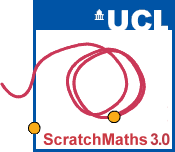Here's the big idea. Maths is difficult in part because of the language in which it is expressed. Can we find a different language - and set of ideas and approaches - that is more open, more accessible and more learnable. And can we find it without sacrificing what makes mathematics work? Our tentative answer is 'yes' - the language of programming might - if we design it right - be just such a language.
ScratchMaths is a two-year computing and mathematics-based curriculum for Key Stage 2 pupils (Years 5 and 6). Its aim is to enable pupils to engage with and explore important mathematical ideas through learning to program. We are using the free online programming environment Scratch.
The ScratchMaths curriculum has been designed and trialled by a team based at the UCL Knowledge Lab in London, England in conjunction with primary teachers and is currently being used in over 50 schools across England.
The set of resources developed through this process are now freely available to download via our Curriculum Materials page.
The project was funded by the Education Endowment Foundation.
- Design key points
Key points of the design:
- Guided by existing programming and mathematics academic research and builds on this work
- Curriculum materials address aspects of both Computing and Mathematics national curriculum at Key Stage 2
- Spans 6 modules of work and 40+ hours of activities
- Incorporates teacher guides, classroom presentations, Scratch starter projects, additional challenges and reference posters
- Intended to be used by teachers who have undergone at least two days of professional development to support understanding of the 'big ideas' behind the curriculum and pedagogical approach
- Research key points
Key points of the research:
- To explore specific aspects of the learning process involved in developing mathematical ideas through programming
- To identify the gap between the design intentions and practical delivery of the intervention as this process evolves
- To establish a positive connection between learning to program and mathematical attainment
 Close
Close


